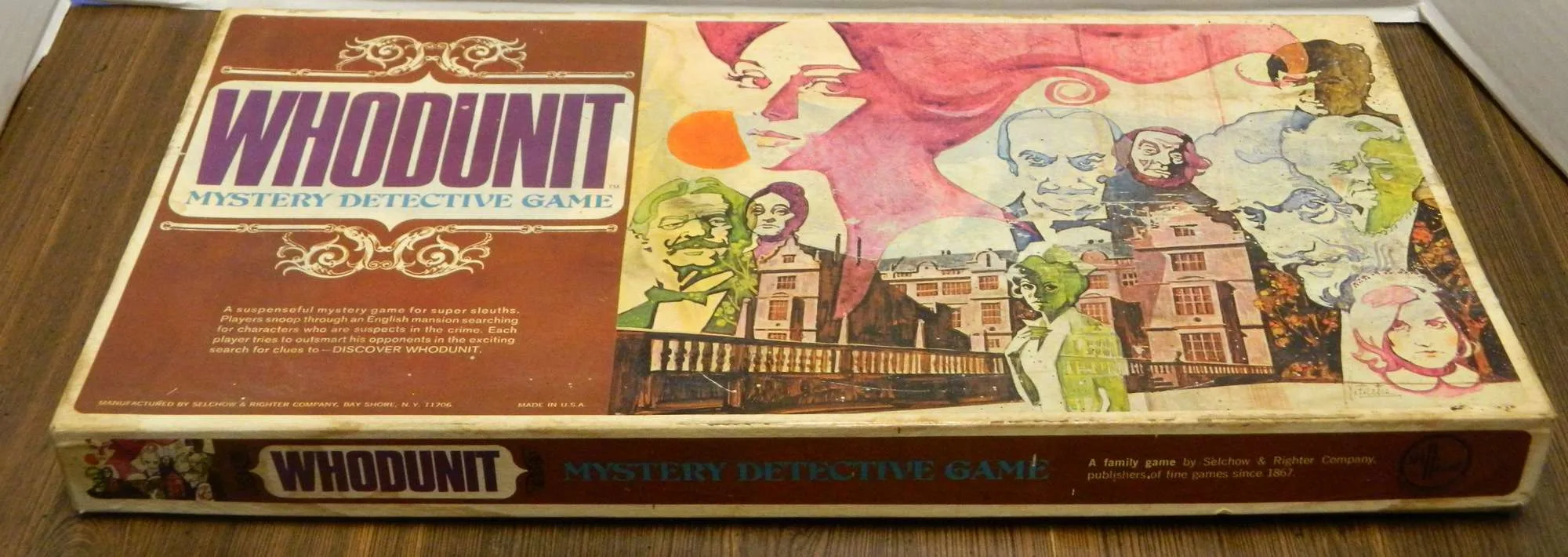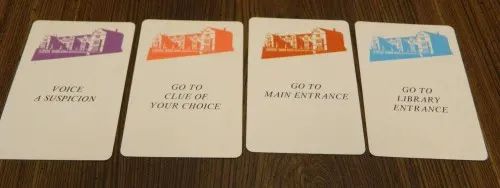How to Play
Objective
To be the first player to determine the murderer, weapon used, scene of the crime, and the motive for the murder.
Setup
Each player picks a pawn and places it on the main entrance space. Each player gets a detective sheet to keep track of clues learned throughout the game. The ten suspect cards are separated from the rest of the deck. The rest of the cards are shuffled and placed in the center of the game board.
Three discs from each category are selected at random to be the clues for the game. These discs are placed on the corresponding spaces on the game board: suspects in the parlour, weapons in the trophy room, scenes in the conservatory, and the motives in the library. The other discs not chosen are shuffled with one disc being given to each player. The remaining discs are placed in a pile next to the main entrance.
Each player rolls the dice with the highest roll getting to go first.
A Player’s Turn
To begin each turn the current player rolls the dice. The player can choose to use one or both of their dice for their movement. For example if a four and a five were rolled, the player could move four, five or nine spaces. Movement must also follow these rules:
- The player can move in any direction but they cannot move onto the same space twice on the same turn.
- Players can not move to the main entrance unless they are instructed to by a card or they want to make a guess at the solution.
- Two players can occupy the same space. The player who lands on another player’s space by exact count can voice a suspicion against the player that they landed on the same space as (see Solving the Crime).
- If a player lands on a “Clue” space they may look at that clue and then place it back onto the board face down in the same spot they took it from.
- If a player lands on a “Take A Card” space they take the top card from the draw deck and immediately do what the card says.
The Cards
When landing on a “Take A Card” space, players can draw one of the following cards:
- Voice A Suspicion: The player is allowed to ask all of the other players a question in order to try and find out what alibi cards the other players are holding (see Solving The Crime section).
- Go To Clue Of Your Choice: The player gets to move their pawn to any clue space on the game board and they then get to look at that clue.
- Go To Main Entrance: The player moves their pawn to the main entrance space. If there are any alibi discs still on the space, the player gets to take one of them and add it to their hand. If there are no alibis remaining, besides moving their piece nothing else happens.
- All of other cards are self-explanatory.
If the deck of cards runs out of cards, the discard pile is shuffled and forms the new draw pile.
Solving the Crime
The main mechanic in Whodunit is to try to figure out which suspect, weapon, scene and motive where involved in the murder. In Whodunit there are two different types of clues (referred to as alibis). The alibis placed out on the circles on the board are considered clues pertaining to the crime. Alibis held by other players and stacked by the the main entrance are considered clues not related to the crime. In order to figure out the suspect, weapon, scene, and motive players need to find the three relevant clues pertaining to that topic. Once a player figures out all three relevant clues, they can reference their detective sheet in order to find the correct suspect, weapon, scene, or motive.
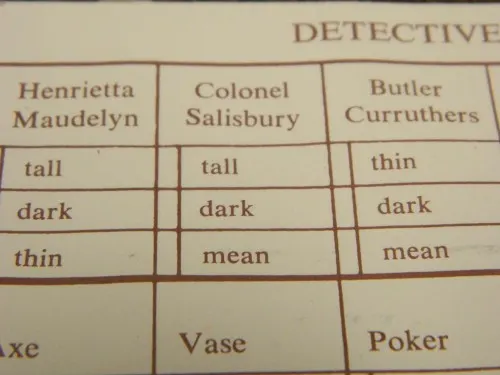
A player has determined that the three suspect clues relevant to the case are “tall”, “dark”, and “mean”. By referencing the detective sheet they can determine that Colonel Salisbury is the killer.
Players can find one of the relevant clues by landing on the corresponding clue space (by exact count). They look at the card and mark it down on their detective sheet. The token is then placed back onto the same space face down.
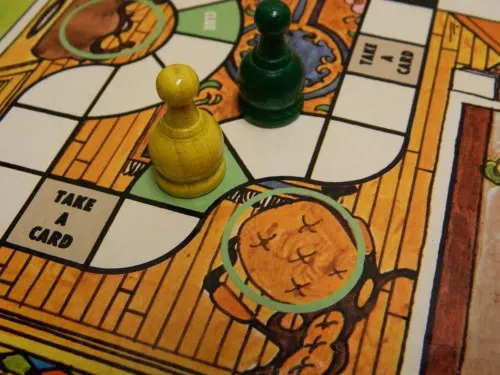
The yellow player has landed on a clue space. They would get to look at the clue that was placed in the circle in the bottom right corner.
Players can also find out about the crime by asking the other players about tokens that they are holding in their hands. When a player draws a Voice a Suspicion card they can ask all of the players. If they land on the same space as another player they can just ask that player. When voicing a suspicion the player gets to pick two alibis from the suspect, weapon, scene and motive categories. For example a player could ask “Was the weapon SHARP or was the scene COLD?” If asking multiple players the player could ask all of the players the same thing or they could ask each player something different.
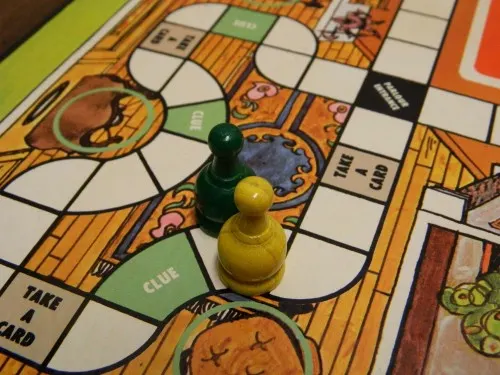
The green player has landed on the same space as the yellow player. The green player will get to ask the yellow player about two of the alibi tokens.
If the player has a disc for one of the alibis asked for they must show it to the player who asked without showing any of the other players. If they have both of the alibis asked for they can choose which one to show to the other player.
End of Game
When a player believes they know the suspect, weapon, scene, and motive they must move towards the main entrance. In order to make their guess they must land by exact count on the main entrance. The player must choose the suspect card that matches their guess as well as state the weapon, scene and motive for the murder. If all of the players agree with the player’s guess, that player wins the game.
If one or more players disagree with the guess though, any player is allowed to challenge the accusation. Every player circles on their detective sheets what they believe to be the correct suspect, weapon, scene, and motive. The player who guessed will then look at all of the alibi tokens (not letting anyone else see) on the game board to determine whether they were correct. If they were correct they win the game.
If they were wrong they put the alibi tokens back onto the correct spaces on the game board. The guessing player is eliminated from the game and any alibi tokens in their hand are placed at the main entrance. If the player thinks they are correct but after flipping over the alibis on the board it is determined that they were wrong, all players look at the items they circled on their detective sheet. Any players who guessed all of the items correctly is declared a winner. If multiple players guess right they are all winners.
Alibi Combinations
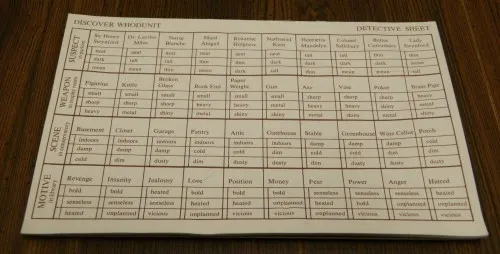
Here is a picture of the detective sheet from Whodunit. This sheet shows the different alibi combinations in the game.
In case your copy of the game has run out of detective sheets here is a chart showing what group of alibi tokens reference each suspect, weapon, scene, and motive. If you have detective sheets remaining you can skip the rest of this section.
Suspects
Sir Henry Swynford
- neat
- dark
- mean
Dr. Lucifer Miles
- neat
- tall
- mean
Nurse Blanche
- neat
- tall
- thin
Maid Abigail
- neat
- thin
- mean
Roxanne Holgrave
- neat
- thin
- dark
Nathaniel Kent
- neat
- dark
- tall
Henrietta Maudelyn
- tall
- dark
- thin
Colonel Salisbury
- tall
- dark
- mean
Butler Curruthers
- thin
- dark
- mean
Lady Swynford
- thin
- mean
- tall
Weapon
Figurine
- small
- sharp
- heavy
Knife
- small
- sharp
- metal
Broken Glass
- small
- sharp
- shiny
Book End
- small
- heavy
- metal
Paper Weight
- small
- heavy
- shiny
Gun
- small
- metal
- shiny
Axe
- sharp
- heavy
- metal
Vase
- sharp
- heavy
- shiny
Poker
- sharp
- shiny
- metal
Brass Pipe
- heavy
- metal
- shiny
Scene
Basement
- indoors
- damp
- cold
Closet
- indoors
- damp
- dim
Garage
- indoors
- damp
- dusty
Pantry
- indoors
- cold
- dim
Attic
- indoors
- cold
- dusty
Gatehouse
- indoors
- dim
- dusty
Stable
- damp
- cold
- dim
Greenhouse
- damp
- cold
- dusty
Wine Cellar
- damp
- dim
- dusty
Porch
- cold
- dim
- dusty
Motive
Revenge
- bold
- senseless
- heated
Insanity
- bold
- senseless
- unplanned
Jealousy
- heated
- senseless
- vicious
Love
- bold
- heated
- unplanned
Position
- bold
- heated
- vicious
Money
- bold
- unplanned
- vicious
Fear
- senseless
- heated
- unplanned
Power
- senseless
- bold
- vicious
Anger
- senseless
- unplanned
- vicious
Hatred
- heated
- unplanned
- vicious
Review
The deduction genre of board games have been around for a long time. One of the oldest deduction games is the “classic” 1949 Parker Brothers game Clue. Most people have played Clue at some point in their lives. Some people love Clue while others don’t particularly care for it. I personally enjoy the game but I wish it had more strategy and required a little less reliance on the roll of the dice.
With the success Parker Brothers has had with Clue, it is not surprising that other companies have tried to replicate its’ success. While Clue has stood the test of time, a lot of these other games have failed to ever become popular. Today I am going to look at one of these games Whodunit made by Selchow and Righter Company in 1972. While trying to improve on the game Clue, Whodunit ends up making the game worse by removing almost all of the deduction out of the game.
A Deduction Game With No Deduction
When looking at Whodunit it is easy to see that the game took a lot of inspiration from Clue. From the task of solving a murder, to quirky named suspect, and even a similar looking mansion; if it wasn’t made by a different company you might have thought that Whodunit was a spinoff of Clue. The main mechanic of both games involve moving around the mansion looking for clues to help solve the murder. Throughout both games you can also ask questions of the other players in order to get information out of them.
The only significant difference between the two games is the idea of the alibi tokens in Whodunit. In Clue each player gets cards which tell them which suspects, weapons and locations were not involved in the murder. In Whodunit you use alibi tokens. Players need to figure out the three alibi descriptors for each element of the crime in order to solve the case. At first this idea interested me since I thought it could bring some interesting things to the game. I found out pretty quickly though that this mechanic is seriously flawed.
The problem with the new mechanic is that it eliminates almost all of the deduction out of the game. Unless you guess well you will rarely ever get any information out of the other players. There is just not enough alibi tokens in the game. The problem is the game couldn’t really add any more alibi tokens or it would be way too confusing to search the charts since each token added would have added many more options for each element. For the entire game I only ever had one alibi token in my hand. The max number of tokens any player had in the entire game was two. The only way to really get any information out of other players is to just get lucky and guess one of the tokens they are holding so they have to show it to you.
Now in the game Clue you can actually get information out of situations when you get no information from the players. If none of the other players are holding a specific card, you know that card must be part of the solution. That is not the case in Whodunit since you will play most or the entire game without all of the tokens even being in play. In the game I played, the game ended before all of the tokens even brought into the game. Without all of the tokens being in play you can’t get any information out of a question where no one shows you a token since the token you are asking for may very well be sitting on the main entrance waiting for someone to pick it up. In the entire game I think only one player was able to deduce one thing and that was mostly due to luck.
Since you can’t really deduce anything, Whodunit pretty much becomes a roll and move game with a mystery theme. Quickly in the game I figured out that deduction was pretty much pointless so I just focused on landing on all of the clue spaces. At least in my opinion it is just easier to land on all of the clue spaces rather than try to randomly guess what tokens the other players were holding. I liked that the game gave you some options with movement since you can use one or both of your dice for movement. Even with that ability, if you don’t roll well you will not win. At the end of the game I played, two players had the mystery solved at the same time which lead to one player ultimately winning the game just because they rolled better at the end of the game and they were able to reach the main entrance quicker.
Luck is Key
While there is quite a bit of luck in Clue, it pales in comparison to Whodunit. With little to no deduction, the winner will almost always come down to who is luckiest.
Getting a second or third alibi token is the biggest advantage in the game that a player can get. The reason getting extra tokens is important is that it can save you a lot of time since it could actually help you figure out the alibi’s connected to the crime without having to go to all of the associated spaces on the board. Getting extra tokens relies entirely on luck though since the only way you can pick them up is by drawing a card that lets you go to the main entrance. While I think it is stupid that such a key advantage is determined by a random card draw, there is nothing else the game could have done since if you could move to the main entrance to draw an additional token, everyone would do it and it would then come down to a roll of the dice for whom would end up getting the extra tokens.
When making suspicions you are relying almost entirely on luck. You pretty much need to luck into guessing what tokens the other players hold. Based on the game I played at least 80% of the suspicions lead nowhere. If a player is able to successfully guess a token that another player holds they can gain a big advantage over the other players. The luck in this aspect is worse in Whodunit than in Clue because unlike in Clue you can’t really use a lot of information to help narrow down what your opponents may have.
Finally as with almost all roll and move games, whoever rolls the best will win the game.
Quick Tidbits
- The components reminded me a lot of Clue. The game board in particular looks a lot like Clue’s game board. I didn’t like the alibi tokens and I would have preferred that they had been cards instead of circular discs since they would have been easier to hold.
- Due to being reliant on the roll of the dice, you will encounter situations where your whole turn is essentially wasted since all you can do with your roll is to move towards your next destination. This is quite boring and hurts players that end up with a lot of these types of turns.
- Apparently Whodunit has a second edition that was released in 1985 which does include some changes to the rules. I wonder if this edition of the game actually adds some deduction back into the game?
Final Verdict
The designers at Selchow and Righter Company tried to do something new with Whodunit. By replacing the cards from Clue with descriptions of the elements of the crime, players need to piece these clues together in order to figure out the suspect, weapon, location, and motive of the crime. While an interesting idea, this just makes the game overly complicated for no real reason. With this change in gameplay almost all of the deduction was removed from Clue. What is left is a roll and move game with a mystery theme.
If you like deduction games you are probably just better off playing Clue or one of the other good deduction games. If you really like deduction games, you want to try something new, and you can find the game for cheap you may get something out of Whodunit. I found Whodunit to be a failed experiment though.

